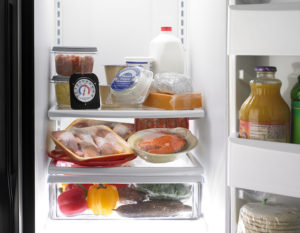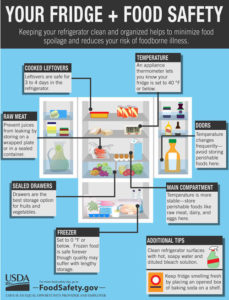The other day, I opened the refrigerator at home and saw a package of fresh (raw) sausage on the top shelf. Knowing I didn’t put it there, I moved it to the bottom shelf, grabbed what I was looking for and shut the door. My husband saw this and gave me the “What did I do wrong now?” look . . .
While I’m happy he remembered to put the sausage in the fridge, it wasn’t in the correct place. Simply put, food in the refrigerator(PDF)should be stored top to bottom based on cooking temperatures. The top shelf or shelves should be for foods that are ready to eat and may receive no further heat treatment before consumption. The bottom shelf is for raw meats, poultry and seafood. These foods may contain bacteria that can make you sick, so we don’t want any risk of them dripping or leaking onto other foods. Also, raw meat, poultry and seafood should always be wrapped and placed in a container or on a tray to prevent liquids from leaking onto your shelves.
Additionally, it is important to make sure your refrigerator is at the right temperature. We want to keep food out of the Temperature Danger Zone(PDF), which is from 40 degrees Fahrenheit to 140 degrees Fahrenheit, so for cold storage our goal is below 40 degrees. To keep the temperature of the food just below 40 degrees, you need to have the air temperature of the refrigerator set to between 37 and 39 degrees. The only way to know the air temperature of your fridge is to use an appliance thermometer. Hang or sit one on the refrigerator door or near the front of the center shelf.
This graphic from the USDA FoodSafety.gov website can help you understand more about safe refrigerator storage.


